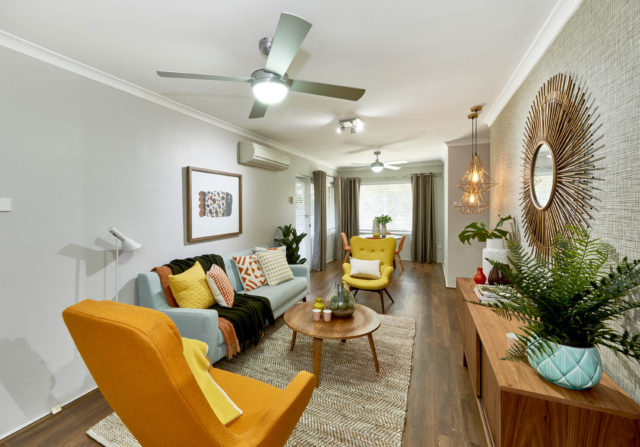By Cherie Barber
Few can resist the airy feeling of open plan, with the free-flowing sense of space and light, airy interiors. However, without a good sense of how to furnish and light a large, open plan area, it can feel cavernous and cold; about as homely as a storage warehouse.
The key is correct ‘zoning’, using elements like lighting, artworks, rugs, colour and furniture to create invisible rooms within the open plan, along with unifying elements that merge all the spaces seamlessly together.

Let’s come together
First up, you want a sense of cohesion as your foundation. When the whole space is empty it should feel like one big room. You achieve this with devices like flooring all at the same level (particularly if it flows inside/out), the same type or at least the same coloured flooring and the same colour palette throughout. Now you have a blank slate to work with.
Go with the flow
Next you need to create a flow that makes sense. To a large extent, the placement of windows and doors will dictate this. In typical open plan, you have a combination of kitchen, dining and living. It makes practical sense that the kitchen flows into the dining space. Depending on whether the space is L-shaped, square or rectangular, the lounging area may be an extension of these two ‘rooms’ or adjoin them. If you’re lucky, the interior will spill to an outdoor entertaining area.
Get in the zone
Now you create warmth and character and give definition to the open plan through zoning. You’ve decided where your designated rooms are, but it’s time to communicate this to the world.
Start with the kitchen. As the cabinetry and splashback are already in place by now, lighting is the most powerful tool at your disposal. Pendant lights over an island bench or breakfast bar, with obligatory dimmers, create a casual eating/work zone. High beam for chopping and low beam for relaxing with a wine after dinner.
Pride of place
For the dining area, a large table and chairs is an obvious statement piece, but think about how you can make this ‘room’ cosier. A rug that comfortably fits the chairs when pulled out (a 75cm overlap from the edge of the table will generally suffice) provides an obvious border. And again, a feature light over the centre of the table creates ambience and interest. Consider a mirror, artwork or even a console on the wall adjoining the dining table. It will help to anchor the space. And remember, a long piece of furniture, with floating legs, against the longest wall will accentuate the length of a room.
Easy living
The lounging area is really where you want to think about intimacy and warmth, and catering for a variety of moods. It’s a place to read, relax, watch TV and chat with family and friends. Along with the kitchen, it’s the social focus of the home. A mix of lighting such as floor lamps, table lamps and overhead lighting is ideal.
A nice big rug will define the space, and furnishings like a sofa and chairs create the boundary (a modular sofa that forms a right angle does a great job of this). A wall-hanging TV opposite the sofa is probably inevitable, but just try not to make it the focus of the whole room.
–Cherie Barber is the director of Renovating for Profit, a company that teaches everyday people how to buy and renovate properties for a profit.
For more on Cherie Barber and James Treble’s Interior Design for Profit online course












